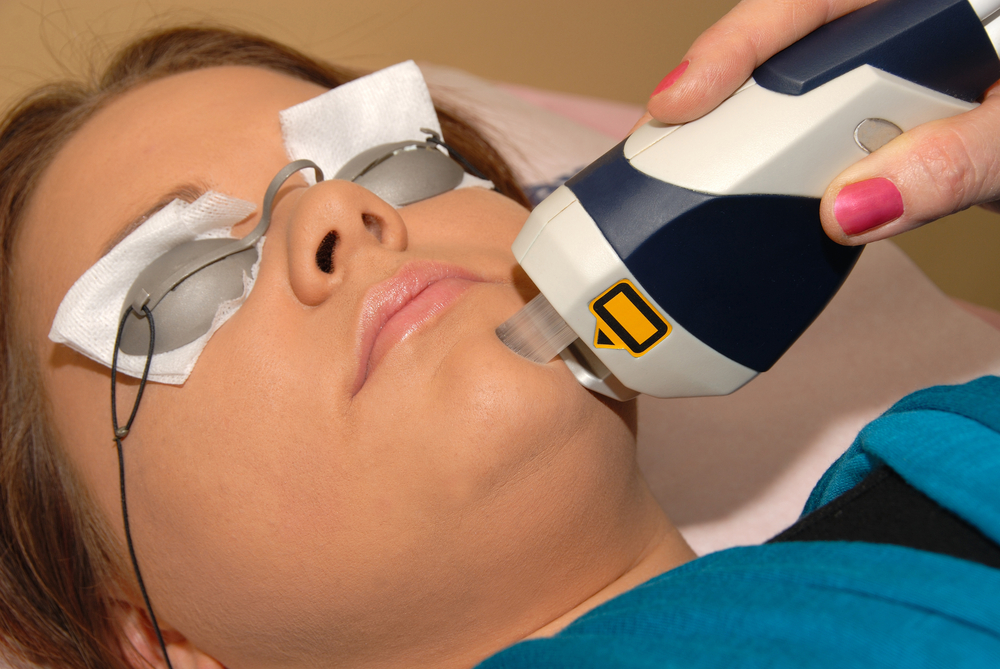Laser toning treatments can effectively correct sun spots, acne scars, melasma and other conditions that affect the skin’s pigmentation, whether they’re at the surface or deep in the dermal layers.
You probably already know about the many applications of laser and other light-based technologies in the aesthetic industry: they’re used for everything from hair and tattoo removal to body contouring, and are beating out other non-invasive skin treatments by way of efficacy and popularity.
Addressing pigmentary disorders with lasers or light treatments may also allow you to avoid outdated, chemical-laden skin “bleaching” creams, as these new high-tech devices are now being used to blast away melasma, hyperpigmentation, and other common skin concerns.
Here we discuss the benefits of laser toning and pigmentation removal procedures.
What Causes Pigmentation on the Face?
Uneven pigmentation can occur when the body’s pigment-making melanocytes, the melanin-forming cells in the skin, become damaged or lose efficiency. This is a part of the natural aging process, but is also a common side effect of excessive sun damage — another great reason to make sure you’re wearing sunscreen every day.
Aging, hormonal imbalance, and certain diseases can also disrupt melanin production, causing the skin to darken in spots or patches.
What Can Laser Toning Treat?
Dermal lasers are used for a wide range of skin ailments, including hyperpigmentation, red spots, dark spots, wrinkles, and a slew of other pigmentation concerns.
If you’re looking for a proven method to improve pigmentation or want to erase a birthmark or scar, you’ll definitely want to consider the latest laser treatment options, which can help address the following concerns, among others.
- Melasma — If you suffer from melasma — a form of hyperpigmentation which causes brown to gray-brown patches on the face — you already know it’s one of the most difficult skin conditions to treat, especially for those with darker skin tones. Dermatological studies report that laser toning effectively improves the appearance of pigmented lesions and dark spots. However, laser treatments can only control melasma, not cure it.
- Post-Inflammatory Hyperpigmentation — This epidermal pigmentation condition, often referred to as PIH, generally occurs following an injury, burn, inflammatory lesion or skin disorder. It is believed to be more common in people of Hispanic or African American ancestry, although technically it can occur on any skin type. Specific lasers, cooling devices, and wavelengths can be used to treat PIH. Many dermatologists recommend pairing these treatments with topical lightening creams for the best results.
- Dark spots — If you’ve noticed brown spots on your face that aren’t associated with melasma, PIH or another skin condition, they might be caused by sun damage. The right laser treatment can effectively zap these dark spots away. Some dermatologists and aesthetic specialists recommend the use of ruby lasers for such applications, but many laser and light therapy options are available.
- Freckles — Laser freckle removal is fast gaining traction in the dermatological world. Recent studies have shown that one of the newest laser technologies, fractional CO2 laser, can reduce the color density of freckles by more than 50% in a month.
- Acne scarring — Some dermatologists have also started channeling lasers to address acne scars. By stimulating collagen production deep in the dermis/epidermis, lasers can help improve the appearance of enlarged pores, wrinkles, fine lines, and moderate to severe acne scars.
- Rosacea and redness — Rosacea redness is most frequently caused by telangiectasias, also known as spider veins. Specific lasers can be used to destroy these broken blood vessels on the cheeks and nose. The International Rosacea Foundation recommends certain types of lasers, but warns that treatments may actually cause rosacea to worsen. Because rosacea sufferers are much more likely to experience adverse reactions to certain skincare therapies, treatment should only be provided by highly trained professionals.
- Dark circles — Some dermatologists also recommend pairing dermal fillers such as Restylane, Juvederm, or Belotero with laser toning to treat under-eye circles. For obvious reasons, patients and providers alike must wear special protective goggles to avoid irreversible eye damage during light-based treatments.
How Laser Toning Works
Put simply, laser toning is the process of using laser energy to penetrate specific layers of the skin and break apart pigments, which often surface as a result of sun damage, aging, acne, and other skin conditions.
Unlike traditional laser skin resurfacing treatments, laser toning is performed using non-ablative lasers, which work by heating up the targeted tissue without actually destroying it. This creates what dermatologists call a ‘controlled thermal injury,’ triggering a natural response in the body to produce more collagen and elastin. After the procedure is complete, the body’s immune system processes excess pigmentation and leftover particles to clear away discoloration.
There is typically no pre-treatment required for laser toning, although some specialists will instruct their patients to avoid sun exposure for a few weeks beforehand.
Some skincare specialists apply a topical analgesic or local anesthetic to minimize discomfort during the procedure, but most patients don’t experience any significant pain. However, it is common for the skin to feel warm to the touch immediately after the treatment session is complete.
The number of treatments required primarily depends on your particular skin type and concerns. Almost all non-ablative laser procedure options require several sessions — typically between four and ten treatments in total.
According to Dr. David J. Goldberg, one of America’s top dermatologists and laser surgeons, some of the most popular laser toning options include the nanosecond, picosecond, and Laser Genesis systems. These techniques cause very few side effects, outside of some mild discomfort that can be described as a tingling sensation.
You should be able to return to your regular activities immediately following your laser treatment. You will be instructed to avoid prolonged exposure to the sun, and will most likely be required to wear a broad-spectrum 30 SPF sunscreen, applied every two hours.
It is important to note that thermal injury is not advised in certain cases, namely for patients with darker skin, as it can cause discoloration and scarring. According to recent studies, the use of lasers for melasma should only be considered when all other modalities have failed. However, many new technologies have improved the effectiveness of lasers over a wide range of skin types. An experienced dermatologist or skincare specialist will be able to choose the appropriate treatment protocol.
Types of Cosmetic Lasers
A wide variety light-based treatments are marketed as skin toning lasers. However, not all of these are lasers in the true sense of the term. Confusion arises when Intense Pulse Light (IPL) treatments and lasers are referred to interchangeably by inexperienced or misinformed care providers.
“LASER” is actually an acronym for “light amplification by stimulated emission of radiation,” and applies to devices that produce a single wavelength of light. On the other hand, Intense Pulse Light (IPL) treatments are less focused than lasers, and shine multiple wavelenghts over a larger area.
While both these approaches use light-based energy to address common skin conditions, different devices are used to target specific skin types and concerns. For instance, IPL systems can be used effectively in the treatment of pigmented lesions and capillary malformations. However, medical providers will in some cases favor fractional lasers to achieve the same goals.
The best way to determine which type of treatment is suited to your particular case is to talk to trained and certified aesthetic medical provider. He or she will be able to create a customized plan that’s tailored to your needs.









